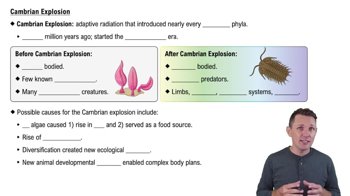Table of contents
- 1. Introduction to Biology2h 40m
- 2. Chemistry3h 40m
- 3. Water1h 26m
- 4. Biomolecules2h 23m
- 5. Cell Components2h 26m
- 6. The Membrane2h 31m
- 7. Energy and Metabolism2h 0m
- 8. Respiration2h 40m
- 9. Photosynthesis2h 49m
- 10. Cell Signaling59m
- 11. Cell Division2h 47m
- 12. Meiosis2h 0m
- 13. Mendelian Genetics4h 41m
- Introduction to Mendel's Experiments7m
- Genotype vs. Phenotype17m
- Punnett Squares13m
- Mendel's Experiments26m
- Mendel's Laws18m
- Monohybrid Crosses16m
- Test Crosses14m
- Dihybrid Crosses20m
- Punnett Square Probability26m
- Incomplete Dominance vs. Codominance20m
- Epistasis7m
- Non-Mendelian Genetics12m
- Pedigrees6m
- Autosomal Inheritance21m
- Sex-Linked Inheritance43m
- X-Inactivation9m
- 14. DNA Synthesis2h 27m
- 15. Gene Expression3h 20m
- 16. Regulation of Expression3h 31m
- Introduction to Regulation of Gene Expression13m
- Prokaryotic Gene Regulation via Operons27m
- The Lac Operon21m
- Glucose's Impact on Lac Operon25m
- The Trp Operon20m
- Review of the Lac Operon & Trp Operon11m
- Introduction to Eukaryotic Gene Regulation9m
- Eukaryotic Chromatin Modifications16m
- Eukaryotic Transcriptional Control22m
- Eukaryotic Post-Transcriptional Regulation28m
- Eukaryotic Post-Translational Regulation13m
- 17. Viruses37m
- 18. Biotechnology2h 58m
- 19. Genomics17m
- 20. Development1h 5m
- 21. Evolution3h 1m
- 22. Evolution of Populations3h 52m
- 23. Speciation1h 37m
- 24. History of Life on Earth2h 6m
- 25. Phylogeny2h 31m
- 26. Prokaryotes4h 59m
- 27. Protists1h 12m
- 28. Plants1h 22m
- 29. Fungi36m
- 30. Overview of Animals34m
- 31. Invertebrates1h 2m
- 32. Vertebrates50m
- 33. Plant Anatomy1h 3m
- 34. Vascular Plant Transport2m
- 35. Soil37m
- 36. Plant Reproduction47m
- 37. Plant Sensation and Response1h 9m
- 38. Animal Form and Function1h 19m
- 39. Digestive System10m
- 40. Circulatory System1h 57m
- 41. Immune System1h 12m
- 42. Osmoregulation and Excretion50m
- 43. Endocrine System4m
- 44. Animal Reproduction2m
- 45. Nervous System55m
- 46. Sensory Systems46m
- 47. Muscle Systems23m
- 48. Ecology3h 11m
- Introduction to Ecology20m
- Biogeography14m
- Earth's Climate Patterns50m
- Introduction to Terrestrial Biomes10m
- Terrestrial Biomes: Near Equator13m
- Terrestrial Biomes: Temperate Regions10m
- Terrestrial Biomes: Northern Regions15m
- Introduction to Aquatic Biomes27m
- Freshwater Aquatic Biomes14m
- Marine Aquatic Biomes13m
- 49. Animal Behavior28m
- 50. Population Ecology3h 41m
- Introduction to Population Ecology28m
- Population Sampling Methods23m
- Life History12m
- Population Demography17m
- Factors Limiting Population Growth14m
- Introduction to Population Growth Models22m
- Linear Population Growth6m
- Exponential Population Growth29m
- Logistic Population Growth32m
- r/K Selection10m
- The Human Population22m
- 51. Community Ecology2h 46m
- Introduction to Community Ecology2m
- Introduction to Community Interactions9m
- Community Interactions: Competition (-/-)38m
- Community Interactions: Exploitation (+/-)23m
- Community Interactions: Mutualism (+/+) & Commensalism (+/0)9m
- Community Structure35m
- Community Dynamics26m
- Geographic Impact on Communities21m
- 52. Ecosystems2h 36m
- 53. Conservation Biology24m
30. Overview of Animals
Overview of Animals
Problem 3d
Textbook Question
Textbook QuestionTrue or false? New major animal body plans have continued to evolve since the Cambrian about 550 million years ago.
 Verified step by step guidance
Verified step by step guidance1
Understand the context of the Cambrian period: The Cambrian period, occurring about 540 million years ago, is known for the 'Cambrian Explosion,' a time of rapid diversification in animal life where many major animal groups (phyla) first appeared in the fossil record.
Define 'major animal body plans': Major animal body plans refer to the fundamental structural architectures of animals, categorized into different phyla based on characteristics such as body symmetry, segmentation, and limb disposition.
Evaluate evolutionary changes post-Cambrian: After the Cambrian period, while there have been many evolutionary changes and adaptations within these phyla, no fundamentally new major animal body plans have emerged. Evolution has mostly involved diversification within the established phyla.
Consider the evidence from paleontology: Fossil records post-Cambrian show adaptations and speciation within existing phyla but do not indicate the emergence of new phyla with distinct, new body plans.
Conclude the statement: Based on the understanding of what constitutes a 'major animal body plan' and the evidence from fossil records, the statement is false. New major animal body plans have not continued to evolve significantly since the Cambrian period.
Recommended similar problem, with video answer:
 Verified Solution
Verified SolutionThis video solution was recommended by our tutors as helpful for the problem above
Video duration:
31sPlay a video:
Was this helpful?
Key Concepts
Here are the essential concepts you must grasp in order to answer the question correctly.
Cambrian Explosion
The Cambrian Explosion refers to a significant period in Earth's history, around 541 million years ago, when a rapid diversification of life forms occurred. This event led to the emergence of most major animal phyla and established the foundational body plans that characterize modern animals. Understanding this period is crucial for evaluating the evolution of body plans over time.
Recommended video:

Cambrian Explosion
Evolutionary Biology
Evolutionary biology is the study of the processes that drive the diversity of life on Earth, including natural selection, genetic drift, and speciation. It provides the framework for understanding how new traits and body plans can arise and adapt over time. This concept is essential for assessing whether new major body plans have emerged since the Cambrian.
Recommended video:

History of Evolutionary Theory Example 1
Body Plans
Body plans refer to the structural organization of an organism, including its symmetry, segmentation, and the arrangement of its organs. Major animal body plans, such as bilateral and radial symmetry, have been foundational in the classification of animals. Recognizing how these plans have evolved or remained stable is key to answering questions about the continuity of evolution since the Cambrian.
Recommended video:
Guided course

Body Axes

 5:58m
5:58mWatch next
Master Overview of Animals - 1 with a bite sized video explanation from Jason Amores Sumpter
Start learningRelated Videos
Related Practice











